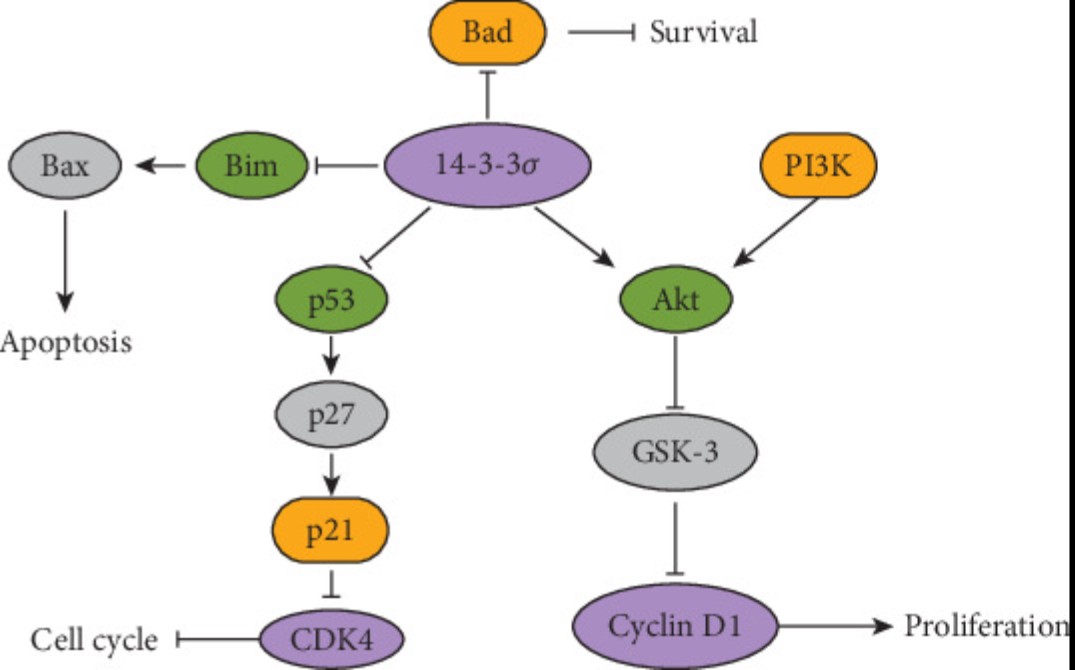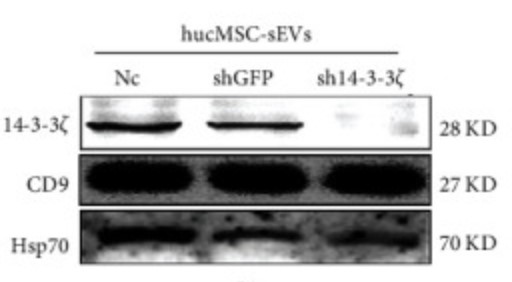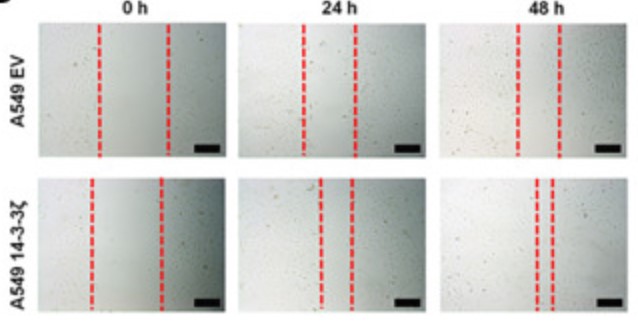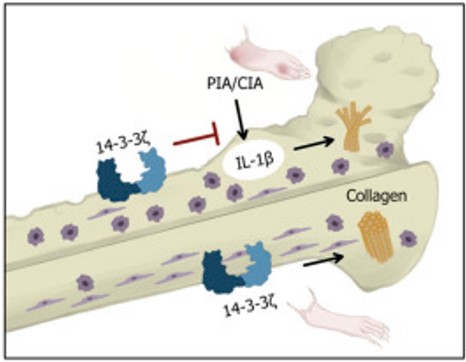YWHAZ
-
Official Full Name
tyrosine 3-monooxygenase/tryptophan 5-monooxygenase activation protein, zeta polypeptide -
Overview
14-3-3 proteins are highly conserved proteins which play a role in both signal transduction and progression through the cell cycle by binding to and regulating several different proteins. 14-3-3 proteins activate tyrosine and tryptophan hydroxylases and protein kinase C. They mediate signal transduction by binding to phosphoserine-containing proteins. There are at least 7 mammalian isoforms: alpha, beta, gamma, delta, epsilon, zeta, and eta. An eighth subtype, termed theta has been found in rat brain. The 14-3-3 proteins exists in vitro and in vivo as either homo- or heterodimers which interact via their N-terminal domains and are subject to phosphorylation by protein kinase C. 14-3-3 proteins are localized in the cytoplasm of neurons in the cerebral cortex and are axonally transported to the nerve terminals. They may be present at lower levels in various other eukaryotic tissues. Northern blot analysis has shown expression of the eta chain in cultured cell lines derived from various tumors. -
Synonyms
YWHAZ;tyrosine 3-monooxygenase/tryptophan 5-monooxygenase activation protein, zeta polypeptide;tyrosine 3 monooxygenase/tryptophan 5 monooxygenase activation protein, delta polypeptide , YWHAD;14-3-3 protein zeta/delta;14 3 3 delta;14 3 3 zeta;KCIP
Recombinant Proteins
- Human
- Zebrafish
- Mouse
- Chicken
- Rhesus macaque
- Rat
- E.coli
- Mammalian Cells
- Insect Cells
- HEK293
- Yeast
- His
- GST
- T7
- Non
- Avi
- Fc
- DDK
- Myc
- SUMO
- Flag
Background
What is YWHAZ protein?
YWHAZ (tyrosine 3-monooxygenase/tryptophan 5-monooxygenase activation protein zeta) gene is a protein coding gene which situated on the long arm of chromosome 8 at locus 8q22. This gene product belongs to the 14-3-3 family of proteins which mediate signal transduction by binding to phosphoserine-containing proteins. This highly conserved protein family is found in both plants and mammals, and this protein is 99% identical to the mouse, rat and sheep orthologs. The encoded protein interacts with IRS1 protein, suggesting a role in regulating insulin sensitivity. The YWHAZ protein is consisted of 245 amino acids and its molecular mass is approximately 27.7 kDa.
What is the function of YWHAZ protein?
YWHAZ also known as 14-3-3ζ, acts as an adapter protein implicated in the regulation of a large spectrum of both general and specialized signaling pathways. It binds to a large number of partners, usually by recognition of a phosphoserine or phosphothreonine motif, leading to the modulation of the activity of the binding partner. It also promotes cytosolic retention and inactivation of TFEB transcription factor by binding to phosphorylated TFEB.
YWHAZ Related Signaling Pathway
YWHAZ protein is a highly conserved serine/threonine kinase protein binding chaperone involved in the regulation of several signaling pathways, including PI3K/Akt, MAPK/ERK, Wnt/β-catenin, JNK, etc. In the PI3K/Akt signaling pathway, YWHAZ interacts with Akt protein to promote the activation and stabilization of Akt, thus participating in the regulation of cell proliferation, survival and cell cycle.

Fig1. 14-3-3σ may generate an increase in cell proliferation, an increase in the proportion of cells in S phase, and a contribution to the chemoresistance of CCA toward gemcitabine. (Qiao Wu, 2020)
YWHAZ Related Diseases
YWHAZ protein has been implicated in the occurrence and development of many diseases, including cancer, neurological diseases, and cardiovascular diseases. Several studies have found that YWHAZ is abnormally expressed in various types of cancer and is associated with tumor proliferation, invasion, and metastasis. In addition, YWHAZ is also involved in the development and functional regulation of nerve cells, playing an important role in neurological diseases like autism, schizophrenia and so on. In addition, YWHAZ has been associated with diseases of the cardiovascular system, such as atherosclerosis and myocardial infarction.
Bioapplications of YWHAZ
The application of YWHAZ protein in the field of biology is mainly focused on the study of disease mechanisms, especially in the fields of oncology, neurobiology and developmental biology.
Case Study
Case Study 1: Siqi Yin, 2022

Fig1. Western blot experiments verified the knockdown efficiency of 14-3-3ζ.
Case Study 2: Yingjie Qing, 2021

Fig2. The 14-3-3ζ promotes NSCLC cell mobility, migration and invasion.
Quality Guarantee
High Purity
Fig1. SDS-PAGE (YWHAZ-6580H) (PROTOCOL for western blot)
.
Fig2. SDS-PAGE (YWHAZ-843H) (PROTOCOL for western blot)
Involved Pathway
YWHAZ involved in several pathways and played different roles in them. We selected most pathways YWHAZ participated on our site, such as Cell cycle,Oocyte meiosis,PIK-Akt signaling pathway, which may be useful for your reference. Also, other proteins which involved in the same pathway with YWHAZ were listed below. Creative BioMart supplied nearly all the proteins listed, you can search them on our site.
| Pathway Name | Pathway Related Protein |
|---|---|
| Hepatitis B | VDAC3,IFNA14,NFATC2,MAPK10,CREB3L3,IRF7,CYCS,KRAS,EGR2,IL6 |
| Epstein-Barr virus infection | MAP2K4,POLR2G,CSNK2A2,CDK1,PRKACA,PLCG2,POLR1D,TRAF3,IKBKG,YWHAB |
| Cell cycle | MPEG1.1,KIF18A,CEP57,CDC14A,TGFB3,CCNA1,CEP290,SGOL1,CDK11A,TUBGCP5 |
| Pathogenic Escherichia coli infection | TUBA1C,TUBA3D,ITGB1,TUBB2A,WASL,ROCK1,TUBA8,CLDN1,ACTB,WAS |
| Hippo signaling pathway | WNT8B,NKD1,LATS2,PPP2R2D,MPP5,CRB2,WNT8A,FZD7,SERPINE1,TGFB3 |
| Viral carcinogenesis | HIST1H2BB,PKM2,CCNA1,TRAF3,HIST1H2BQ,POLB,CASP8,REL,ACTN2,HIST2H4 |
| Oocyte meiosis | YWHAG1,CPEB1B,PPP2CB,CPEB2,PRKACBA,CDC20,YWHAE1,CDC27,FBXW11,PPP2R1A |
| PIK-Akt signaling pathway | PIK3R2,PKN1,PIK3CD,IFNA13,ITGA5,FGF21,ITGA2B,IRS1,THBS3,PPP2R3C |

Fig2. Overall model depicts that the absence of 14-3-3ζ results in severe inflammation and bone damage; mainly, increased IL-1β and reduced collagen levels are observed in the naïve and IA-affected animals. (Joshua Kim, 2021)
Protein Function
YWHAZ has several biochemical functions, for example, identical protein binding,poly(A) RNA binding,protein binding. Some of the functions are cooperated with other proteins, some of the functions could acted by YWHAZ itself. We selected most functions YWHAZ had, and list some proteins which have the same functions with YWHAZ. You can find most of the proteins on our site.
| Function | Related Protein |
|---|---|
| protein binding | MRPL44,RBMX2,PYY,DDX41,CSNK1A1,WDR61,SLC4A4,ZWINT,ZC3H14,COPS4 |
| poly(A) RNA binding | ZNF638,VSIG8,G3BP1,CASC3,CCT6A,DDX52,H2-Q10,FNDC3B,NLRP11,CELF2 |
| protein kinase binding | TICAM1,FBXW5,CYLD,CASP9,LCK,RNF138,NGFRAP1,SNAP91,PTPN23,PAK2 |
| protein domain specific binding | SHC4,NEFL,HIST1H4D,CAPG,SCAF1,TADA3,ARHGEF4,HSPA5,ICA1L,STX1B |
| identical protein binding | BNIP2,CLDN15,KCTD13,FBXW7,PARK7,NDE1,EWSR1,CASC3,KCNJ10,DESI1 |
| transcription factor binding | NFATC3,UBA2,HES2,PURA,KAT2B,RNF4,EPAS1,VDRA,CCND1,PBX1 |
| ubiquitin protein ligase binding | RIPK1,NPLOC4,PER1,VCP,STUB1,SCAMP3,KCNH2,SNX9,UBE2K,NGFR |
Interacting Protein
YWHAZ has direct interactions with proteins and molecules. Those interactions were detected by several methods such as yeast two hybrid, co-IP, pull-down and so on. We selected proteins and molecules interacted with YWHAZ here. Most of them are supplied by our site. Hope this information will be useful for your research of YWHAZ.
RAF1;TSC2
Resources
Research Area
Related Services
Related Products
References
- van Rijn, SJ; Riemers, FM; et al. Expression Stability of Reference Genes for Quantitative RT-PCR of Healthy and Diseased Pituitary Tissue Samples Varies Between Humans, Mice, and Dogs. MOLECULAR NEUROBIOLOGY 49:893-899(2014).
- Weber, R; Bertoni, APS; et al. Validation of Reference Genes for Normalization Gene Expression in Reverse Transcription Quantitative PCR in Human Normal Thyroid and Goiter Tissue. BIOMED RESEARCH INTERNATIONAL :-(2014).




